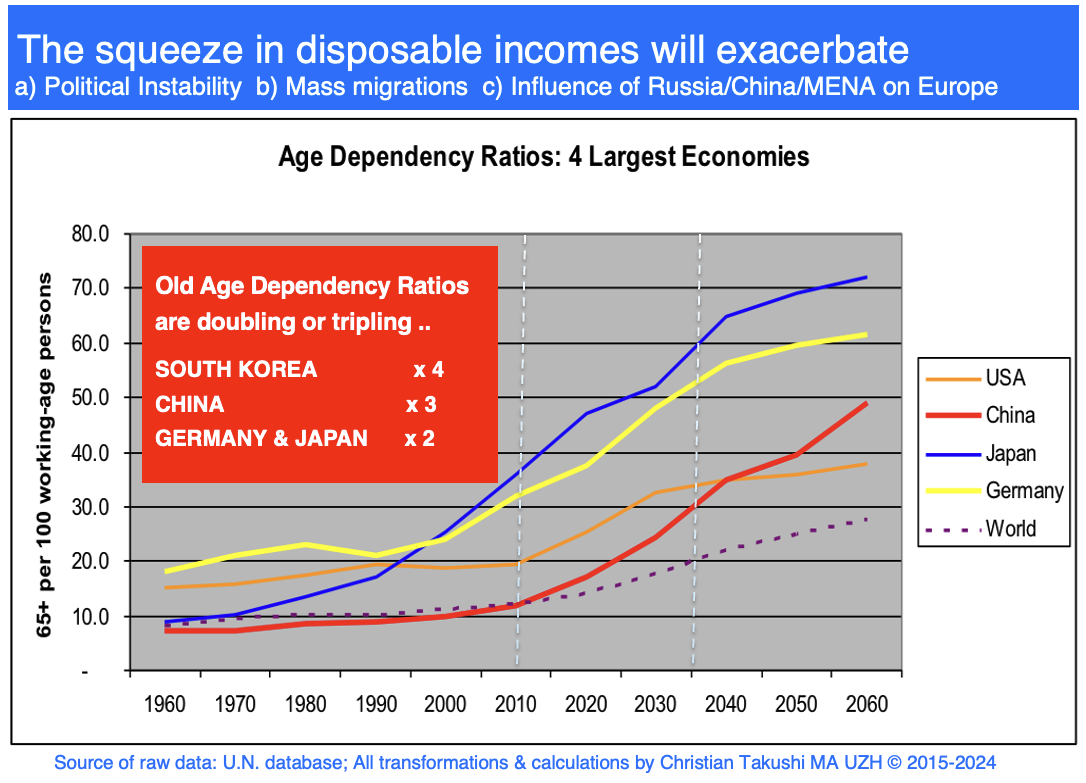By Econ. Christian Takushi, Global Geopolitical Research, Switzerland, 26 Sept 2024 (This report was adapted and truncated for public release, 1 Oct 2024)
Demographics showed us ten years ago where we’d be now
For our recent subscribers:
We only release a report when our analysis significantly deviates from consensus or we shed light on something significant that markets overlook. We don’t want to add to the “noise” out there.
Dear reader
Every now and then it is important to take a step back – specially in the run up to an unprecedented US Election Day. We have been working on a geopolitical round-up of interconnected developments on multiple fronts, but we noticed .. we need to release this report first.
Just as you hear many political and financial leaders lately making bold statements on the campaign trail or at the UN, take a step back and see what the context and backdrop is
I invite you to look at the big picture. There is something we can’t change easily, not over one government administration, not even over three or four: the demographic trajectory of our nations. That can only be significantly altered or changed over 25-40 years.
Please, keep this in mind as you walk through the next few months …
Demographics showed us ten years ago we’d be here .. now
Those of you that follow our research ten years or longer, may remember one of our first analytical charts (see below). We have been tracking the Old-Age-Dependency Ratios for many years: The number of retirees and the number of persons in the labor force – for all key nations.
For many reasons: Demographics matters for economics, politics and geopolitics. Demographics also matters, because at a time when so many governments are tampering with data to underreport inflation and overstate employment & economic growth in order to both boost their approval ratings and to disinform their geopolitical enemies/competitors, you want to look at relevant data that governments can’t easily influence at will.
Thanks to the comprehensive UN population data projections (which are quite accurate) and our aggregate-level analysis, we knew since mid 2013 about the coming simultaneous dramatic deterioration of ODR ratios during 2015-2040 – across most of the Northern Hemisphere. From Canada and USA .. over Ukraine and Russia .. to China and South Korea.
We warned in 2014: The number of Retirees will explode as the Labor Forces will implode – especially across the Northern hemisphere with dramatic impacts on our Middle Class, Political Stability and social-military Security. Europe would be most affected.

We’ve since been analysing how this dramatic shift would drive geopolitics, foreign policy and fiscal-monetary policy between 2015 and 2040 and have been speaking with government, central bank officials and business leaders ever since – to warn them about what is coming and how to prepare.
The impact of the ODR Shock: Impoverishment & Conflict, even Israel
It is comforting to point fingers on another party and to blame governments for the mess in the West. Fact is both conservative and liberal parties have been printing money and driving up massive deficits. In reality many policy makers saw the dangers, but acknowledged it is too late to change course, or politically suicidal to correct our bubbles or simply too difficult to fight the momentum in our political process. People like handouts.
Our unethical monetary-fiscal policies reached way beyond the financial realm. A recurring issue over the past 4’000 years of economic history: The problem is this – the more indebted a nation and the more debased its currency, the more its government will be forced to deflect into Foreign Policy. During the 2015-2040 period we have an extraordinary situation with most large nations in the Northern Hemisphere simultaneously deflecting into Foreign Policy. That means more conflicts, wars – especially in the Middle East. In 2014 we ascertained we will get a new Cold War. But Cold War II would be much more complex, dangerous and costly than the first one.
In a nutshell: Fast rising ODR ratios de facto mean that “real disposable incomes” will shrink over time, so all affected governments will DEFLECT in different ways – like at the end of every big cycle.
In 2014 we began to predict a return of conflicts and wars between countries of the Northern hemisphere. Look at our chart from 2015 (above) – used at our keynote speeches. Our dysfunctional Western democracies face the biggest losses. Since 2015 we have been expecting the growing likelihood of the following phenomena
a) Rising political instability across North America, Europe, Russia, Middle East, Pakistan, China ..
b) Mass migrations
c) Growing influence of Middle East over Europe (and blocked Maritime Routes)
d) Massive fiscal-monetary stimulus by West. economies, biggest bubble ever
e) Three large scale wars in the Northern hemisphere (already 120 conflicts)
Europe is particularly vulnerable, because all world powers project their Foreign Policy and military power into the Middle East. Everyone – from Mexico and Brazil to China and North Korea – is deflecting into the Middle East conflict. Those that don’t know this think Israel and Iran simply failed to keep the peace.
Across MENA and South Asia the enemies of the West have managed to win the support of all key nations along our Maritime Routes. Thus, China and Russia can very easily “choke” over 60% of Europe’s global supply chains.
Thus, even the security of Israel has …
This report has been adapted and truncated here. To request a subscription to our newsletter you can write to info@geopoliticalresearch.com stating your name and country of residence.
Other subtitles/sections in this report ..
- How Eastern powers and Iran can blackmail Europe
- The government is not in control – no one human is
- No easy way out – Losses and opportunities abound
- Total Reset: Asset Corrections vs State Control – European Federation
- Conservative people underestimate the Wealth Illusion
- Why should a majority upend free markets (the backbone of democracy)?
- Helpful remarks
Personal comment
Important note
This report reflects the current state of our research and it could change if more new figures are available, estimates change, policy goals are adapted or the global conditions change.
By Christian Takushi, Economist, Global Geopolitical Research, Switzerland, 26 Sep 2024 (This report was adapted and truncated for public release, 1 Oct 2024)
Geopolitical Research Team
Research made in Switzerland
Geopolitical and economic conditions need close monitoring, because they can change suddenly.
No part of this analysis should be taken or construed as an investment recommendation.

For subscriptions or comments write to info@geopoliticalresearch.com
Since 2016 our newsletter is ranked among the 50 most reliable sources of geopolitical analysis worldwide.